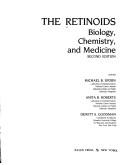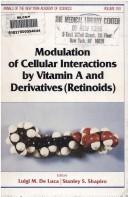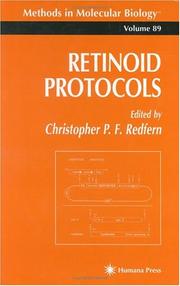| Listing 1 - 10 of 22 | << page >> |
Sort by
|
Book
ISBN: 3642543030 3642543049 Year: 2014 Publisher: Berlin, Heidelberg : Springer Berlin Heidelberg : Imprint: Springer,
Abstract | Keywords | Export | Availability | Bookmark
 Loading...
Loading...Choose an application
- Reference Manager
- EndNote
- RefWorks (Direct export to RefWorks)
In this thesis, the author describes the total synthesis of natural product Maoecrystal V in detail. In the first part of the thesis, the author introduces the research background and reviews the research progress in total synthesis of Maoecrystal V. In the second part, the author develops a novel and concise approach for the stereoselective construction of the tetracyclic model system of Maoecrystal V. The model system is accomplished in 8 steps with 20% yield. In the third part, the author describes the first successful total synthesis of Maoecrystal V and investigates four strategies for constructing the key tetrahydrofuran oxa-bridge skeleton. The total synthesis starts from a known compound and is accomplished in 17 steps with 1.2% yield. The successful total synthesis of Maoecrystal V will contribute to the development of efficient synthetic strategies for natural products and other compounds with complex structures.
Chimie. --- Diterpenes -- Synthesis. --- Diterpenes. --- SCIENCE / Chemistry / Organic. --- Chemistry --- Physical Sciences & Mathematics --- Biochemistry --- Diterpenes --- Synthesis. --- Diterpenoids --- Chemistry. --- Organic chemistry. --- Medicinal chemistry. --- Catalysis. --- Organic Chemistry. --- Medicinal Chemistry. --- Terpenes --- Chemistry, Organic. --- Biochemistry. --- Biological chemistry --- Chemical composition of organisms --- Organisms --- Physiological chemistry --- Biology --- Medical sciences --- Organic chemistry --- Activation (Chemistry) --- Chemistry, Physical and theoretical --- Surface chemistry --- Composition --- Chemistry, Medical and pharmaceutical --- Chemistry, Pharmaceutical --- Drug chemistry --- Drugs --- Medical chemistry --- Medicinal chemistry --- Pharmacochemistry

ISBN: 0781700825 Year: 1994 Publisher: New York : Raven Press,
Abstract | Keywords | Export | Availability | Bookmark
 Loading...
Loading...Choose an application
- Reference Manager
- EndNote
- RefWorks (Direct export to RefWorks)
Retinoids --- Rétinoïdes --- Retinoids. --- 615.27 --- Agents affecting metabolism and cell functions --- 615.27 Agents affecting metabolism and cell functions --- Rétinoïdes --- Vitamin A analogs --- Vitamin A congeners --- Vitamin A derivatives --- Carotenoids --- Diterpenes --- Interphotoreceptor retinoid-binding protein
Book
ISBN: 1536106852 9781536106855 9781536106718 Year: 2017 Publisher: Hauppauge, New York : Nova Science Publishers, Incorporated,
Abstract | Keywords | Export | Availability | Bookmark
 Loading...
Loading...Choose an application
- Reference Manager
- EndNote
- RefWorks (Direct export to RefWorks)
Diterpenes. --- Organic compounds. --- Botanical chemistry. --- Plant chemotaxonomy. --- Chemical plant taxonomy --- Botanical chemistry --- Chemotaxonomy --- Plants --- Phytochemistry --- Plant biochemistry --- Plant chemistry --- Biochemistry --- Botany --- Phytochemicals --- Plant biochemical genetics --- Compounds, Organic --- Organic chemicals --- Carbon compounds --- Diterpenoids --- Terpenes --- Classification
Book
ISBN: 1281829544 9786611829544 9283215761 Year: 2000 Volume: 76 Publisher: [Place of publication not identified] IARC
Abstract | Keywords | Export | Availability | Bookmark
 Loading...
Loading...Choose an application
- Reference Manager
- EndNote
- RefWorks (Direct export to RefWorks)
Vitamin K --- Antineoplastic Agents --- Antiviral Agents --- Carcinogens --- Phenolphthalein --- Naphthoquinones --- Therapeutic Uses --- Noxae --- Phenolphthaleins --- Anti-Infective Agents --- Phytol --- Phenols --- Diterpenes --- Naphthalenes --- Toxic Actions --- Pharmacologic Actions --- Polycyclic Hydrocarbons, Aromatic --- Terpenes --- Chemical Actions and Uses --- Organic Chemicals --- Chemicals and Drugs --- Hydrocarbons, Aromatic --- Hydrocarbons --- Polycyclic Compounds --- Hydrocarbons, Cyclic --- Carcinogens. --- adverse effects.

ISBN: 0897661079 0897661087 9780897661072 Year: 1981 Volume: 359 Publisher: New York (N.Y.): New York Academy of Sciences,
Abstract | Keywords | Export | Availability | Bookmark
 Loading...
Loading...Choose an application
- Reference Manager
- EndNote
- RefWorks (Direct export to RefWorks)
Animal biochemistry --- Zoohistology. Zoocytology --- Vitamin A --- Retinoids --- Cell interaction --- Metabolism --- Congresses --- Physiological effect --- 577.161.1 --- Vitamin A group --- 577.161.1 Vitamin A group --- Retinol --- Carotenes --- Vitamins, Fat-soluble --- Beta carotene --- Retinal (Visual pigment) --- Vitamin A analogs --- Vitamin A congeners --- Vitamin A derivatives --- Carotenoids --- Diterpenes --- Interphotoreceptor retinoid-binding protein --- Metabolism&delete& --- Physiological effect&delete& --- Vitamin A - Metabolism - Congresses --- Vitamin A - Physiological effect - Congresses --- Retinoids - Congresses --- Cell interaction - Congresses --- Vitamin A physiological effects --- Retinoid-binding proteins --- Retinoids metabolism

ISBN: 3540658920 3642636144 3642584837 Year: 1999 Volume: 139 Publisher: Berlin ; Heidelberg ; New York Springer Verlag
Abstract | Keywords | Export | Availability | Bookmark
 Loading...
Loading...Choose an application
- Reference Manager
- EndNote
- RefWorks (Direct export to RefWorks)
In the future' the decade of the 1990s will likely be viewed as a Golden Age for retinoid research. There have been unprecedented research gains in the understanding of retinoid actions and physiology; since the retinoid nuclear receptors were first identified and the importance of retinoic acid in develop mental processes was first broadly recognized in the late 1980s. Between then and now, our knowledge of retinoid action has evolved from one of a near complete lack of understanding of how retinoids act within cells to one of sophisticated understanding of the molecular processes through which retinoids modulate transcription. In this volume, we have tried to provide a comprehensive update of the present understanding of retinoid actions, with an emphasis on re cent advances. The initial chapters of the volume, or Section A, focus on the physicochemical properties and metabolism of naturally occurring retinoids: - N OY provides an uncommonly encountered view of retinoid effects from the perspective of the physiochemical properties of retinoids. - V AKIANI and BUCK lend a perspective on the biological occurrence and actions of retro- and anhydro-retinoids. Section B considers both the retinoid nuclear receptors and their mechanisms of action as well as synthetic retinoids that have been used exper imentally to provide mechanistic insights into receptor actions and have potential therapeutic use for treating disease: - PIEDRAFITA and PFAHL provide a comprehensive review of retinoid nuclear receptor biochemistry and molecular biology.
Retinoids --- Physiological effect. --- Therapeutic use. --- Therapeutic use --- Physiological effect --- Pharmacology. --- Biochemistry. --- Molecular biology. --- Cancer research. --- Dermatology. --- Pharmacology/Toxicology. --- Biochemistry, general. --- Molecular Medicine. --- Cancer Research. --- Medicine --- Skin --- Cancer research --- Molecular biochemistry --- Molecular biophysics --- Biochemistry --- Biophysics --- Biomolecules --- Systems biology --- Biological chemistry --- Chemical composition of organisms --- Organisms --- Physiological chemistry --- Biology --- Chemistry --- Medical sciences --- Drug effects --- Medical pharmacology --- Chemicals --- Chemotherapy --- Drugs --- Pharmacy --- Diseases --- Composition --- Vitamin A analogs --- Vitamin A congeners --- Vitamin A derivatives --- Carotenoids --- Diterpenes --- Interphotoreceptor retinoid-binding protein

ISBN: 0896034380 9786610836888 1280836881 1592595731 9780896034389 Year: 1998 Volume: 89 Publisher: Totowa (N.J.) : Humana press,
Abstract | Keywords | Export | Availability | Bookmark
 Loading...
Loading...Choose an application
- Reference Manager
- EndNote
- RefWorks (Direct export to RefWorks)
Christopher Redfern brings together in Retinoid Protocols a comprehensive collection of key biochemical and molecular methods for retinoid research. These easily reproducible techniques range from methods of handling and analyzing retinoids to advanced protocols for gene targeting, from binding protein function in transgenic animals to the study of nuclear retinoid receptors. In addition, the book makes accessible to all retinoid researchers such advanced techniques as cloning via RT-PCR, fluorimetry methods, recombinant protein purification and characterization, the use of antisense oligonucleotides to study the role of CRABPs, immunological and in situ hybridization methods, photoaffinity labeling, gel-shift analysis, and differential display. Many of the chapters in Retinoid Protocols represent landmarks in retinoid methodology because they give step-by-step instructions for techniques central to understanding cellular control by retinoids. These indispensable techniques will be fundamental for all those working with retinoids, and so will play a key role in the development of new drugs and therapies for treating human disease.
Retinoids --- Laboratory manuals --- Analysis --- Genetic Techniques --- Receptors, Retinoic Acid --- Investigative Techniques --- Carotenoids --- Receptors, Cytoplasmic and Nuclear --- Transcription Factors --- Proteins --- Polyenes --- Pigments, Biological --- Terpenes --- Analytical, Diagnostic and Therapeutic Techniques and Equipment --- DNA-Binding Proteins --- Cyclohexenes --- Biological Factors --- Amino Acids, Peptides, and Proteins --- Alkenes --- Cyclohexanes --- Hydrocarbons --- Organic Chemicals --- Hydrocarbons, Acyclic --- Cycloparaffins --- Chemicals and Drugs --- Hydrocarbons, Alicyclic --- Hydrocarbons, Cyclic --- Laboratory manuals. --- Vitamin A analogs --- Vitamin A congeners --- Vitamin A derivatives --- Diterpenes --- Interphotoreceptor retinoid-binding protein --- Cytology. --- Cell Biology. --- Cell biology --- Cellular biology --- Biology --- Cells --- Cytologists --- Retinoids - Laboratory manuals --- Retinoids - Analysis - Laboratory manuals
Book
ISBN: 0852007434 9401163510 9401163499 Year: 1984 Publisher: Lancaster ; Boston MTP Press
Abstract | Keywords | Export | Availability | Bookmark
 Loading...
Loading...Choose an application
- Reference Manager
- EndNote
- RefWorks (Direct export to RefWorks)
Dermatologic agents --- Etretinate --- Isotretinoin --- Retinoids --- Skin --- Skin diseases --- Vitamin A --- SKIN DISEASES, drug therapy --- VITAMIN A, analogs and derivates --- VITAMIN A, therapeutic use --- Congresses. --- Testing --- Therapeutic use --- Diseases --- Chemotherapy --- Drug therapy --- Analogs & derivatives --- Skin diseases, drug therapy --- Vitamin a, analogs and derivates --- Vitamin a, therapeutic use --- Vitamin a --- Cutis --- Integument (Skin) --- Beauty, Personal --- Body covering (Anatomy) --- Vitamin A analogs --- Vitamin A congeners --- Vitamin A derivatives --- Carotenoids --- Diterpenes --- Interphotoreceptor retinoid-binding protein --- Accutane (Trademark) --- Cis-retinoic acid --- Retinoic acid, Cis --- -Tretinoin --- Tretinoin --- Drugs, Dermatologic --- Dermatopharmacology --- Congresses --- Testing&delete& --- Therapeutic use&delete& --- Diseases&delete& --- Chemotherapy&delete&
Book
ISBN: 9402409432 9402409459 Year: 2016 Publisher: Dordrecht : Springer Netherlands : Imprint: Springer,
Abstract | Keywords | Export | Availability | Bookmark
 Loading...
Loading...Choose an application
- Reference Manager
- EndNote
- RefWorks (Direct export to RefWorks)
The role of vitamin A in living organisms has been known throughout human history. In the last 100 years, the biochemical nature of vitamin A and its active derivative, retinoic acid, its physiological impact on growth processes, and the essential details of its mechanism of action have been revealed by investigations carried out by researchers using vertebrate and more recently invertebrate models to study a multiplicity of processes and conditions, encompassing embryogenesis, postnatal development to old age. A wealth of intercellular interactions, intracellular signaling systems, and molecular mechanisms have been described and the overall conclusion is that retinoic acid is essential for life. This book series, with chapters authored by experts in every aspect of this complex field, unifies the knowledge base and mechanisms currently known in detailed, engaging, well-illustrated, focused chapters that synthesize information for each specific area. In view of the recent information explosion in this field, it is timely to publish a contemporary, comprehensive, book series recapitulating the most exciting developments in the field and covering fundamental research in molecular mechanisms of vitamin A action, its role in physiology, development, and continued well-being, and the potential of vitamin A derivatives and synthetic mimetics to serve as therapeutic treatments for cancers and other debilitating human diseases. Volume II is divided into nine chapters contributed by prominent experts in their respective fields. Each chapter starts with the history of the area of research. Then, the key findings that contributed to development of the field are described, followed by a detailed look at key findings and progress that are being made in current, ongoing research. Each chapter is concluded with a discussion of the relevance of the research and a perspective on missing pieces and lingering gaps that the author recommends will be important in defining future directions in vitamin A research.
Medicine. --- Gene expression. --- Nutrition. --- Biochemistry. --- Plant biochemistry. --- Proteins. --- Systems biology. --- Biomedicine. --- Gene Expression. --- Animal Biochemistry. --- Protein Science. --- Plant Biochemistry. --- Systems Biology. --- Retinoids. --- Biological chemistry --- Chemical composition of organisms --- Organisms --- Physiological chemistry --- Vitamin A analogs --- Vitamin A congeners --- Vitamin A derivatives --- Composition --- Biology --- Chemistry --- Medical sciences --- Carotenoids --- Diterpenes --- Interphotoreceptor retinoid-binding protein --- Biological models. --- Models, Biological --- Alimentation --- Food --- Nutrition --- Health --- Physiology --- Diet --- Dietetics --- Digestion --- Food habits --- Malnutrition --- Genes --- Genetic regulation --- Health aspects --- Expression --- Proteins . --- Nutrition . --- Computational biology --- Bioinformatics --- Biological systems --- Molecular biology --- Phytochemistry --- Plant biochemistry --- Plant chemistry --- Biochemistry --- Botany --- Phytochemicals --- Plant biochemical genetics --- Proteids --- Biomolecules --- Polypeptides --- Proteomics
Book
Year: 2022 Publisher: Basel MDPI - Multidisciplinary Digital Publishing Institute
Abstract | Keywords | Export | Availability | Bookmark
 Loading...
Loading...Choose an application
- Reference Manager
- EndNote
- RefWorks (Direct export to RefWorks)
After the long history of screening, it is becoming difficult to find novel compounds from microorganisms and plants anywhere in the world. Until now, more than about 30,000 marine natural products have been reported. However, with the development of marine natural products research, the hit rate of new compounds is also decreasing. Scientists are now turning their attention to the deep sea, where a high hit rate of novel compounds is expected. Many small compounds and peptides from microorganisms and sponges are with therapeutic activity are shown in this book. This Special Issue Book, “Natural Products from the Deep Sea”, should be useful for the screening of novel and useful compounds from nature.
Medicine --- deep sea marine-derived fungus --- Myrothecium sp. --- myrothecol --- nitric oxide (NO) --- antioxidant activity --- macrolactam --- Deep-Sea-Derived Streptomyces --- abiotic formation --- natural product --- antifungal activity --- Thorectandra choanoides --- tryptophan alkaloid --- indoleamine 2,3-dioxygenase --- aplysinopsins --- GNPS molecular network --- cellular signal transduction --- bioactive metabolite --- deep-sea organisms --- anti-inflammatory agent --- anticancer agent --- Mariana Trench --- Micromonospora provocatoris MT25 --- desferrioxamine --- n-acetylglutaminyl glutamine amide --- 1H-15N 2D-NMR --- genomics --- biosynthetic gene clusters --- stress genes --- crustins --- antibacterial peptides --- hydrothermal vent --- anti-Gram-negative bacteria --- Al-crus 3 and Al-crus 7 --- Trichoderma --- harziane diterpenes --- NO inhibition --- thioester-containing benzoate --- deep-sea-derived fungus --- α-glucosidase inhibitory activity --- docking study
| Listing 1 - 10 of 22 | << page >> |
Sort by
|

 Search
Search Feedback
Feedback About UniCat
About UniCat  Help
Help News
News